
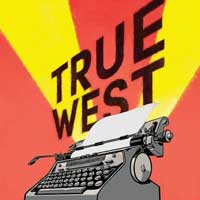 Highly Recommended **** “They had a lot to live up to.” So said one of the women in the audience after watching tonight’s modern revival of Sam Shepard’s “True West” at the Steppenwolf Theatre.
Highly Recommended **** “They had a lot to live up to.” So said one of the women in the audience after watching tonight’s modern revival of Sam Shepard’s “True West” at the Steppenwolf Theatre.
An intimate portrait of Austin and Lee, artfully played by Jon Michael Hill and Namir Smallwood, the play examines the savageness of sibling rivalry gone amok. The story details the bad blood between brothers who intentionally and purposively want to hurt each other.
Their lives predate what we see on stage. Austin has some money, is college-educated, and has a wife and family, whereas Lee is poor, has little formal education, and is as yet unmarried. While both men are superficially so different, they are essentially and remarkably alike; all because they are unwilling to give up their hate for each other.
The play can be understood on many levels. One theme is the seeming incongruities among various characters. It is initially quite funny to watch Lee boast in the first act of his fine ability to play golf, which seems quite incompatible with his personality. Later in the second act, it is charming to watch Austin and Lee transpose their personal quirks. But on a serious note, their odd behavior is indicative of a dysfunctional family where a father drinks too much and a mother (Jacqueline Williams)cares more about her potted plants than fostering a solid relationship with her children. 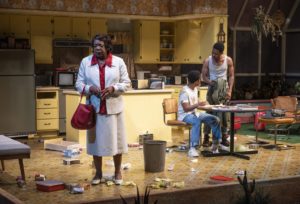
Another theme applies to all those involved in any creative endeavor: Having an excellent idea is one thing, but having the ability to execute it well is another. Lee has a good storyline for a movie about a modern-day Western; this according to his agent Saul Kimmer (Francis Guinan). Austin, in contrast, is the wordsmith with the ability to turn such a story into a cogent script. But one would never know if these are really their true talents, because none of their projects ever come to fruition. Their personalities work against them. In this particular instance, the failure to move forward has to do, in large part, with the fact that neither man is content to combine his talents with the other—so as to truly collaborate without letting ego get in the way. Instead of building upon their combined strengths, both men instead look to each other’s weaknesses, the main fault being that they lack the skill the other supposedly has.
The director Randall Arney could have easily cast white actors in the lead roles, as in the original 1982 production at the Steppenwolf Theatre. Therefore, one has to ask: what does making the family African-American add to the story? Why the additional twist? While Sam Shepard’s script is true to its origins, the inflection in this version clearly differs from the original. There is a dark and unexplored racial dimension to the story, and the irony is not lost upon the actors. In general, this version of the play plays upon—or preys upon—how the majority white population conceives of racial stereotypes within our country. Would an African-American family have had the resources to live a middle-class lifestyle in Burbank, California, circa 1965? Would they have been accepted by their neighbors? Is it believable that a black man would play golf so well in an era before Tiger Woods? There are other such questions that the audience may find themselves asking.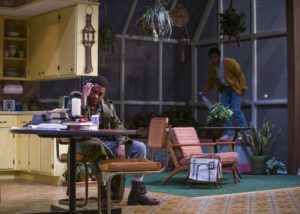
Then too, what of the West? What is the meaning of the title “True West”, and what makes this a good theme for a story? Does the term refer to idealistic and romanticized ideas of cowboys and horses, stagecoaches and ranches? Or is the True West the naked reality of life: as in freeways and traffic and smog in Southern California? Or is it poverty, as in the fact that their daddy can’t afford a new pair of dentures? Or is the True West simply a regional aspect of modern-day culture, namely that of conspicuous consumption and the proliferation of televisions and toasters among us? Does it have to do with the fact that California is supposed to be a great environment for beginning a new venture? To the modern imagination in the 1960s, Hollywood movies are magical. Streets are wide. The sun shines all the time. It is a haven from the cold weather and the hustle-bustle of New York and Chicago. Though the glitz of Hollywood is beguiling with its opportunities for fame and fortune, Austin expresses the thought that all this is fake. But to Lee, who cares if it is real or not? It is an escape. Austin is tired of modern culture and its hype and wants to embrace something authentic: in his case, the raw aspect of humanity; whereas Lee, who has lived long enough in the desert, wants this part of his life to remain in the past and looks forward to civilization.
Speaking of the desert, one of the most crucial parts of the story is the playwright’s continual reference to it. For Shepard, this may be the truest aspect of the True West. The desert is not empty; rather it is deserted. It is not the void from which hope and creativity can spring eternally; rather, it is the darkness of the uncivilized—where the harmless normalcy of crickets chirping sharply contrasts with the howls of wild coyotes: cut-throat and vicious in their desire to kill. Envy, mistrust, and one-upmanship ultimately cause each man to become reduced to the lowest common denominator: survival in the desert. As each gives up on the essence of the person who he truly is—and is truly meant to be—he loses himself to his wild animal nature. Such loss of self ultimately leads to the complete and utter destruction of both brothers: physically, emotionally, and morally.
It’s hard to write about a revival of a play not having seen the well-loved original production. Yet this implicit comparison was first and foremost on the minds of so many audience members who had seen the play some thirty-seven years ago. Therefore, I did my own informal polling and asked some people how the current version compares with the earlier one. Several told me that the original actors (Jeff Perry and Gary Sinese, playing Austin, and John Malkovich, playing Lee) gave a stronger performance. I couldn’t figure out how or why this could be; for the current performance is indeed a very strong one, and the actors cast in their roles are absolutely marvelous! But I then remembered that when the 1982 performance had played at the Steppenwolf, the show was at a different location: a smaller facility with a cozier auditorium with actors who had not yet made it to “the big stage.” Such were the early careers of native Chicago performers, visionaries who foresaw the success of theatre in this city and who helped to create audience demand, not to mention the sizeable venue of the Steppenwolf today. Need I say more?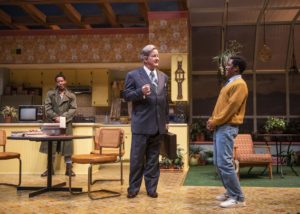
“True West” is now playing through August 25, 2019 in the Downstairs Theatre at the Steppenwolf, located at 1650 N Halsted Street, Chicago. Curtain Times: Tuesday – Friday at 7:30pm, Saturdays and Sundays at 3pm and 7:30pm; Wednesdays at 2pm.
Tickets are $20– $96. Prices subject to change
Twenty $20 tickets are available for subscription shows on the day of the performance at 11am (Mon – Sat) and 1pm (Sun), by phone only. Limit 2 per person. Half-price rush tickets are available one hour before each show. Limited $15 student tickets are available online. (Limit 2 tickets. Must present a valid student ID for each ticket). All groups of 10 or more receive a discounted rate for any performance.
The Steppenwolf is located near all forms of public transportation, bike racks and Divvy bike stands. The parking facility ($13 or $15, cash or card) is located just south of our theater at 1624 N Halsted. Valet parking service ($15 cash) is available directly in front of the main entrance starting at 5pm on weeknights, 1pm on weekends and at 12noon before Wednesday matinees. Limited street and lot parking are also available. For last minute questions and concerns, patrons can call the Steppenwolf Parking Hotline at 312.335.1774.
Committed to making the Steppenwolf experience accessible to everyone, performances featuring American Sign Language Interpretation, Open Captioning and Audio Description are offered during the run of each play. Assistive listening devices and large-print programs are available for every performance, and the Downstairs Theatre is equipped with an induction hearing loop. Wheelchair accessible seating and restrooms are available. Front Bar features a push-button entrance, all-gender restrooms and accessible counter and table spaces.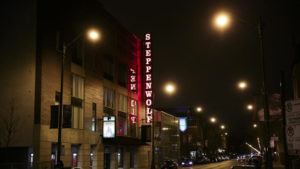
Accessible Performances:
American Sign Language Interpretation: Sunday, July 28 at 7:30pm
Open Captioning: Thursday, August 1 at 7:30pm and Saturday, August 17 at 3pm
Audio Description and Touch Tour: Sunday, August 11 touch tour at 1:30; performance at 3pm
For tickets or more information, contact Audience Services at 312-335-1650 or steppenwolf.org.
To see what others are saying, visit www.theatreinchicago.com, go to Review Round-Up and click at “True West”






More Stories
“Henry Johnson”
“Scary Town” reviewed by Frank Meccia
“Translations”